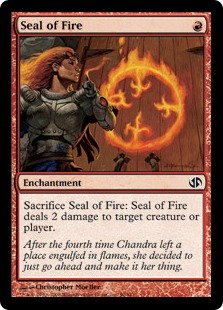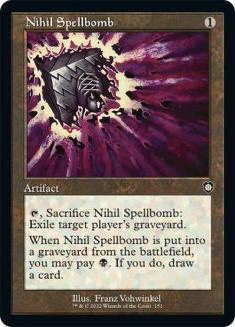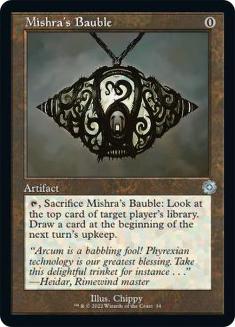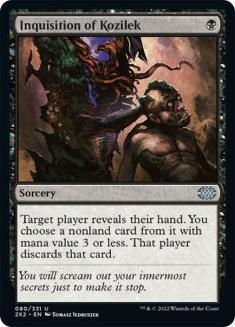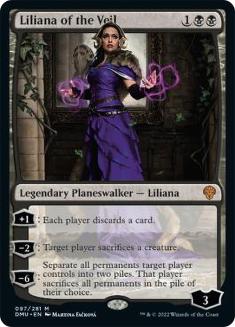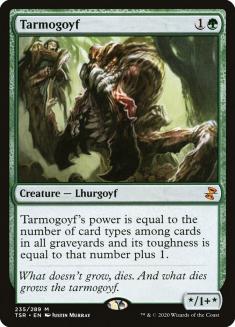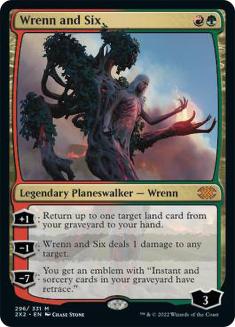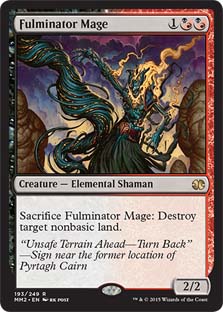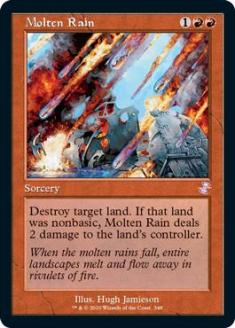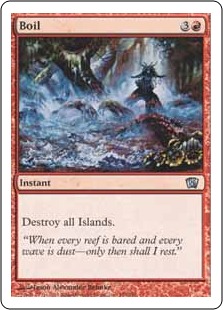With the banning of Arcum’s Astrolabe, Modern has become a bit more interactive. No longer is the format ruled by Cryptic Command and the ability to play four colors. Instead, there are a lot more copies of Tarmogoyf and Thoughtseize running around. Because of that, the king of interaction is in a prime spot to make a comeback in Modern.
Yeah, I’m talkin’ ’bout Jund Midrange.
Jund Midrange tends to win longer games because the average card is better by itself. When you break each card down to its bare essentials, a single Tarmogoyf off the top of the deck is usually enough to run anyone down quickly. Thanks to recent printings, Jund Midrange can go even longer than before, grinding through tons of removal and interaction with the best of the best.
It’s no longer free to splash Uro, Titan of Nature’s Wrath, so the blue decks aren’t nearly as powerful and can’t play the long game as well. That makes your discard a bit better, but it also means your opponents, on average, won’t be able to fight through all your interaction. Playing around a single Cryptic Command isn’t that difficult. And now that Yorion, Sky Nomad is no longer an issue, it’s possible (and profitable) to play different kinds of midrange again.
It’s strange, but Modern is actually one of the most fair formats in Magic at the moment.
Lurrus and the Jund Dream
I wasn’t always a Jund Guy. Long ago, I loathed Jund. I would much rather play Serum Visions than Thoughtseize. It wasn’t until I got clowned over and over by Mr. Brad Nelson in playtesting that I grew a profound respect for the archetype. Navigating games where you have almost complete information can be challenging. Watching your opponent peel on you time and time again when you have them in the vise-grip can drive anyone crazy.
Jund Midrange got a boost in the arm thanks to Lurrus of the Dream-Den as a companion. Pairing it with Mishra’s Bauble gave the deck new life. The only downside was that you couldn’t play Liliana of the Veil, one of the most powerful planeswalkers ever printed. The upside is that you gained a massive amount of percentage points because the entire format stopped being weird and started being more focused on creatures. Jund as a color combination is great at killing creatures.
Playing Lurrus also gave you one of Modern’s most disgusting card advantage engines of all time. Mishra’s Bauble with Lurrus of the Dream-Den meant drawing more cards against opponents that don’t kill it. Casting Unearth or Kolaghan’s Command meant you could rebuy your singleton Lurrus over and over, helping you win longer games against opponents who were playing fair. The fact that you had cheap threats and Scavenging Ooze and all sorts of other powerful goodies at two mana meant you were at a significant advantage against virtually any opponent that didn’t also have a companion. It made non-companion decks obsolete.
When they changed the companion rule, it opened things up a bit. But I kept asking the same question over and over: why weren’t people just playing more copies of the companion in their maindeck? If your entire strategy revolves around Yorion, would it potentially be better to max out on them? One reason we didn’t get to play more than one Lurrus is because the companion requirement did not allow for you to play more than one. Now is the perfect time to try a version of Jund Midrange, or any old-school companion build, with the companion in the main.
Creatures (10)
Planeswalkers (5)
Lands (22)
Spells (23)
- 2 Seal of Fire
- 4 Mishra's Bauble
- 3 Thoughtseize
- 2 Maelstrom Pulse
- 4 Inquisition of Kozilek
- 2 Nihil Spellbomb
- 2 Kolaghan's Command
- 4 Fatal Push
Sideboard

VFS has been a long-time Magic Online grinder, and I find virtually nothing wrong with this list. You could make a some arguments to play Kroxa, Titan of Death’s Hunger; Lightning Bolt; or a number of other tools, but that’s the best part about a midrange deck. You can alter cards to fit whatever holes are getting exploited. In order to play four copies of Mishra’s Bauble and Lurrus, you have to make some cuts. For example, I think Grim Flayer would be excellent in this deck, but I just don’t know how to make it fit.
Lurrus is the best card in your deck, but playing it requires so many slots that you can’t fit everything. Playing Lurrus also means playing some “less than ideal” cards like Seal of Fire in order to get max value. Lurrus is powerful because it’s a way to gain a recurring advantage. If your opponent can’t kill it, Lurrus should dominate any game where your opponent is playing fair. The recursive tools at your disposal vary based on what you need to interact with. Seal of Fire is particularly strong against any Noble Hierarch strategy.
I fully expect creature-based decks to return in force. Seal of Fire is one key component to this archetype because it can be played proactively, allowing you to use all your mana each turn. With Lurrus, getting that extra removal spell is key in a matchup where killing all the auxiliary creatures is important. Seal of Fire can also be used aggressively to deal the last few points of damage to the opponent. Like Lightning Bolt before it, Seal of Fire is less efficient, but the versatility of throwing a removal spell at your opponent’s face is big. It’s especially cool that it helps grow Tarmogoyf too.
While Uro is a little on the downswing, it’s still around and still annoying as hell. Many Modern decks utilize the graveyard, which makes the value of Nihil Spellbomb hard to quantify. On occasion, it will outright steal a game against Dredge. In other spots, it will act like Mishra’s Bauble and cycle over and over. It’s also another card type for Tarmogoyf.
It’s pretty sweet that all of the weird cards that gain value from Lurrus also pump Tarmogoyf. That makes some of your aggressive draws a bit more explosive, closing games a full turn earlier on occasion. It also means burn spells from the opponent will be less likely to kill your Tarmogoyf in the early turns. It won’t always matter, but in the games where it does it can make all the difference.
Many argued that banning Mishra’s Bauble would make Lurrus palatable in Modern before the companion rule was even changed. That one-two punch accrued so much value for so little investment. Using Mishra’s Bauble alongside fetchlands in the early turns allowed for a little bit of card selection, helping you hit land drops or find removal in tight spots. Here, even without Lurrus as a companion, we’re able to use it in many similar ways. The only difference is that we won’t always have the ability to cast Lurrus on the third turn anymore!
Mishra’s Bauble has become a Modern staple. Its efficiency is unmatched, and it just so happens to make Lurrus an excellent card, even after the companion mechanic got nerfed. The two pair together perfectly, giving any midrange deck willing to play both a card advantage engine in a color combination that might not have something similar.
Lurrus fits into this archetype so fluidly, and yet so drastically changes how it looks compared to previous years. Having a card like Lurrus add so much to an existing archetype is rare, but it’s definitely given Jund Midrange the shot in the arm it needed to get back on the map.
These two staples are key for making sure all the unfair decks in Modern don’t overrun you. With so many weird archetypes seeing play, discard spells are some of your best Game 1 cards. You can interact with virtually everyone, stifling their development for a single mana. Stripping a combo or control deck of their best card can make all the difference. As someone who’s played quite a few combo decks in the past, a single discard spell combined with a fast clock can steal a lot of games.
As you start to learn Jund Midrange a bit better, you’ll see more and more spots where sideboarding out discard spells is important. As you play matchups with longer games, a single drawn discard spell in the later turns can mean death, but getting to that point can make all the difference. Finding the right balance is a huge deal, and that type of big brain technology is only something you learn over time.
This card is currently better than Lightning Bolt, but I could definitely see some formats where the opposite is true. Being more aggressive and attacking your opponent’s life total with your removal spells is huge in some cases. There’s a reason Lightning Bolt was the default one-mana removal spell in Modern for years. The printing of Fatal Push helped Jund deal with cheap, large creatures where Lightning Bolt would falter. The adoption of Fatal Push meant a push away from aggression and toward more controlling strategies.
In our Lurrus version of Jund Midrange, winning longer games is key. Having Fatal Push control more opposing creatures means the games can go longer, giving you more turns to assemble Lurrus plus Bauble. At some point, and in a build without Lurrus, playing Lightning Bolt alongside Fatal Push might be feasible, but Seal of Fire is currently getting the nudge due to its utility with both Lurrus and Tarmogoyf.
Turning Lurrus from a companion into a minion means you aren’t forced to abide by the companion rule. That means we get to unlock Liliana of the Veil. I’ve long thought Liliana of the Veil to be the best card in Jund decks since I’ve won so many games with it, and lost so many games to it. It gives you a powerful grip on the rest of the game if your opponent can’t kill it immediately, and a couple of cards in the exchange if they can.
Leveraging Liliana of the Veil is often one of the more challenging aspects of Jund Midrange, though it is much easier now that Lurrus makes us resource-rich. Gaining a bunch of raw resources helps alleviate the pressure of Liliana’s discard effect, but it also makes emptying your hand a bit more difficult.
Liliana of the Veil can be your MVP against a lot of different archetypes. You’d be surprised at how often it’s your best topdeck while also being fine in multiples.
These are the bread and butter of the deck, giving you a small army of cheap creatures to pressure the opponent while also providing you some choice meat to rebuy with Lurrus as the game goes late. Scavenging Ooze is getting the nod currently, but my next goal will be finding a potential build that uses Grim Flayer instead. I want to get aggressive, and I think it’ll be really easy to get delirium when we’re already playing Mishra’s Bauble and Seal of Fire.
Tarmogoyf is the default aggressive choice for Jund Midrange. It isn’t always that way, and could change in the future, but it’s just so efficient and that’s been the name of the game for Jund forever. Tarmogoyf pairs so well with Lurrus and all the tools that come with it that I can find little reason to play anything else.
Wrenn and Six is currently the flex slot, but it’s so good when it’s good that it might just be too important to ever cut fully again. Having it in the early turns means never running out of land drops, which is a pretty big deal when the games get stripped down to their bare essentials each time. When the minus ability kills a creature, it feels very hard to lose the game. When you don’t have a fetchland in the opening turns and can’t get anything back, those are the games you’ll start to question Wrenn and Six and wish it was virtually anything else.
Fighting Over Other People’s Land
The sideboard is very obviously slanted toward one goal: attacking mana. One thing your maindeck is great against is opposing interaction. Big mana decks, and current blue decks, don’t really go hard on the interaction. They aren’t vulnerable to removal and aren’t so bad against discard either. Even Liliana of the Veil has trouble keeping pace with Cryptic Command and Uro.
Tron and Uro and Primeval Titan and all these ramp decks just need to be taken down a peg, and we’ve got the right tools for the job.
This is a classic, and one I’m excited to see make a return. I’d like to pair it with more goodies like Unearth to get some double-ups, but using it alongside Kolaghan’s Command will have to be enough for now.
In some control matchups, Fulminator Mage is a fine threat that blows up a land if they ever decide to interact with it. In big mana matchups, it’s Stone Rain, and that’s good enough. Fulminator Mage gained a lot of points with the banning of Arcum’s Astrolabe because basic lands aren’t nearly as widely played. Everyone’s back to “normal” manabases featuring fetchlands and shocklands.
This one is a bit of a head-scratcher, as you don’t normally play eight ways to kill lands. I think the biggest change in theory here is that Jund Midrange seems to be pretty solid against anyone not ramping up to big baddies. Having all this land destruction means hitting your opponent from multiple angles: lands and hand. Constricting a particular resource or two is a big deal, but more importantly, you’re able to sideboard out all your removal spells when they’re terrible.
Molten Rain and Fulminator Mage aren’t exactly ideal, but it’s a bit harder to play Magic against an opponent that dodges virtually all of your interaction. Having eight cards that kill lands is a great way to make sure you have the means to control your opponent’s development.
Molten Rain is also a bit more aggressively slanted. If you come across a Mono-Green Tron deck or something, those few points of damage might make all the difference.
Boil is a heater and one that will regularly catch people off-guard. I’m not certain it’s the best card for the slot, as something like Choke might be cheaper and have a similar effect. It’s certainly one of those cards from an old core set that seems pretty unfair to one color.
You really hate to see it.
Jund Is as Jund Does
There’s really nothing special about Jund. It’s a midrange deck that has disruption of multiple kinds, removal, and efficient threats. Lurrus was a major part of its resurgence over the last few months, but moving that from a companion build to a maindeck build has been a pretty large shift. I’m excited to see what this new version can do, and try out some alterations down the road.
If you’re a fan of Jund Midrange in any form, this new version is cool as hell and I highly recommend it. It has all the old bells and whistles, and has quite a few remnants from one of the more recent revivals. If you played any with Jund Midrange with Lurrus over the last few months, you should feel right at home.
The removal of Arcum’s Astrolabe makes playing those “Four-Color Blue” decks a lot harder. That means they’re functionally ceasing to be as they once were. That’s obviously a great thing for Jund Midrange, as it means playing Cryptic Command comes with a more significant cost. Playing three or more colors should not be easy, and definitely shouldn’t be painless.
I’ll likely be focusing on Modern over the next few weeks. The lack of changes to Pioneer virtually killed my desire to play the format. It’s weird that my enjoyment of a format is almost entirely based on whether Glorybringer is playable or not. There’s a good chance that I delve into Historic at some point, but how soon depends on when I finally discover which cards are legal and which are not. Guess I’ll go check out Patrick Chapin’s article from earlier this week!



